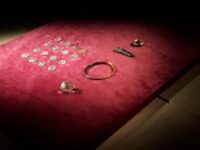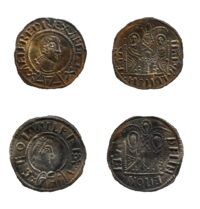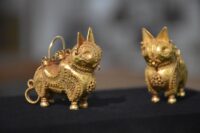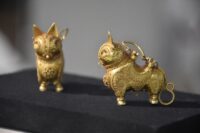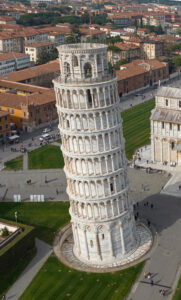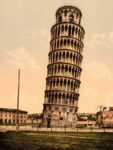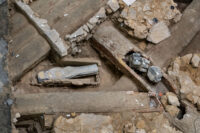 The two sarcophagi discovered early this year in an excavation at the intersection of nave and transept of Notre-Dame de Paris are beginning to reveal their histories, and one of them has named its owner. The lead coffin has a bronze plaque identifying the deceased as Antoine de la Porte, a canon of Notre Dame Cathedral who died in 1710. The other lead coffin, anthropoid in shape and found in a deeper archaeological layer, is certainly older, but its exact date and the identity of its occupant are still unknown.
The two sarcophagi discovered early this year in an excavation at the intersection of nave and transept of Notre-Dame de Paris are beginning to reveal their histories, and one of them has named its owner. The lead coffin has a bronze plaque identifying the deceased as Antoine de la Porte, a canon of Notre Dame Cathedral who died in 1710. The other lead coffin, anthropoid in shape and found in a deeper archaeological layer, is certainly older, but its exact date and the identity of its occupant are still unknown.
Burials in the cathedral took place throughout the medieval and modern periods, with the prime location near the altar reserved for the most prominent individuals. Lead coffins were luxury goods as well, affordable only to the elite. These two examples are very different. One is anthropoid (shaped like the human body), one square. They have different methods of construction, different alloys and they were found in different archaeological layers so are different ages.
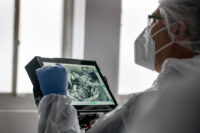 The coffins were examined at the Forensic Institute of Toulouse University Hospital using the latest and greatest medical imaging technology. For a week this past November, the sarcophagi were studied with microscopes, probes, CT scanners and X-rays. Lead is usually a good preserver of remains, but in this case both sarcophagi were damaged. Some organic material has nevertheless survived in the coffins, including bones, textile remains, beard and head hair and plant remains. The team has taken samples of the remains inside the coffins and will examine them to determine, if possible, the geographical origin, diet, illnesses, cause, date and age of death of the deceased.
The coffins were examined at the Forensic Institute of Toulouse University Hospital using the latest and greatest medical imaging technology. For a week this past November, the sarcophagi were studied with microscopes, probes, CT scanners and X-rays. Lead is usually a good preserver of remains, but in this case both sarcophagi were damaged. Some organic material has nevertheless survived in the coffins, including bones, textile remains, beard and head hair and plant remains. The team has taken samples of the remains inside the coffins and will examine them to determine, if possible, the geographical origin, diet, illnesses, cause, date and age of death of the deceased.
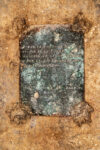 We know Antoine de la Porte’s age and date of death with exactness, thanks to the epitaph on his coffin. He died December 24th when he was 83 years old. De La Porte was a wealthy and influential prelate who contributed an extraordinarily large sum to build a new altar in fulfillment of the Vow of Louis XIII, a pledge issued by the king in 1638 consecrating himself and France to the Virgin Mary in gratitude for the birth of his son and heir. The pertinent text of the Vow:
We know Antoine de la Porte’s age and date of death with exactness, thanks to the epitaph on his coffin. He died December 24th when he was 83 years old. De La Porte was a wealthy and influential prelate who contributed an extraordinarily large sum to build a new altar in fulfillment of the Vow of Louis XIII, a pledge issued by the king in 1638 consecrating himself and France to the Virgin Mary in gratitude for the birth of his son and heir. The pertinent text of the Vow:
[W]e have declared and we declare that, taking the very holy and glorious Virgin Mary as special protectress of our kingdom, we particularly consecrate to her our own Self, the State, our Crown and our subjects, entreating her to inspire in us a holy conduct and to so diligently defend this kingdom against the endeavors of all its enemies that, whether it suffers the plague of war or enjoys the sweetness of the peace we implore from God from the depth of our heart, it may never depart from the path of grace leading to the path to glory. And so that posterity does not fail to follow our will in the matter, as a monument and immortal sign of the present consecration that we are making, we shall build anew the great altar of the Cathedral of Paris with an image of the Virgin holding in her arms her precious Son descended from the Cross and representing us at the foot of the Son and the Mother as offering to them our crown and our scepter.
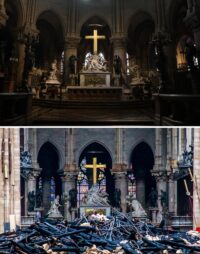 The king never did get around to building that new altar in his lifetime. Instead, said son and heir, King Louis XIV undertook to fulfill his father’s vow and commissioned construction of an elaborate new high altar in December 1699. Two years later, the War of Spanish Succession began. From 1701 to 1714, all the money Louis XIV could scrape up was poured into his military adventures. Realizing his original plan for Notre-Dame was now unaffordable, he scaled it down. Even the more modest project was still out of his financial reach, so in 1708 the good Canon Antoine de la Porte made an enormous donation of 10,000 livres that jump-started construction. The Pietà statue mentioned in the vow was completed in 1723; the one of Louis XIII kneeling was completed in 1715. Louis XIV added one of himself kneeling with his hand on his heart on the other side. The full reconstruction of the altar was completed in 1725.
The king never did get around to building that new altar in his lifetime. Instead, said son and heir, King Louis XIV undertook to fulfill his father’s vow and commissioned construction of an elaborate new high altar in December 1699. Two years later, the War of Spanish Succession began. From 1701 to 1714, all the money Louis XIV could scrape up was poured into his military adventures. Realizing his original plan for Notre-Dame was now unaffordable, he scaled it down. Even the more modest project was still out of his financial reach, so in 1708 the good Canon Antoine de la Porte made an enormous donation of 10,000 livres that jump-started construction. The Pietà statue mentioned in the vow was completed in 1723; the one of Louis XIII kneeling was completed in 1715. Louis XIV added one of himself kneeling with his hand on his heart on the other side. The full reconstruction of the altar was completed in 1725.
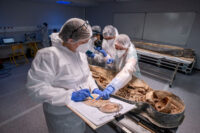 The anthropoid lead coffin was not conveniently labelled for posterity, alas. The skeletal remains indicate the deceased was a man between 24 and 40 years old. His pelvic bone and upper legs show evidence that he rode horses from a very young age. Researchers have dubbed him “the cavalier” because of this. He suffered some kind of chronic disease that had destroyed almost all of his teeth by the time he died. Long before that when he was just an infant, his skull was deformed by being bound with a headband. (Deliberate cranial modification is widespread over every human population continent going back tens of thousands of years, including among the aristocracy of France and Italy in the High Middle Ages, see this portrait of a princess by Pisanello now in the Louvre, for example.) Interestingly, the top of his skull was sawed off, evidence that he was embalmed, an extremely rare practice in the Middle Ages.
The anthropoid lead coffin was not conveniently labelled for posterity, alas. The skeletal remains indicate the deceased was a man between 24 and 40 years old. His pelvic bone and upper legs show evidence that he rode horses from a very young age. Researchers have dubbed him “the cavalier” because of this. He suffered some kind of chronic disease that had destroyed almost all of his teeth by the time he died. Long before that when he was just an infant, his skull was deformed by being bound with a headband. (Deliberate cranial modification is widespread over every human population continent going back tens of thousands of years, including among the aristocracy of France and Italy in the High Middle Ages, see this portrait of a princess by Pisanello now in the Louvre, for example.) Interestingly, the top of his skull was sawed off, evidence that he was embalmed, an extremely rare practice in the Middle Ages.
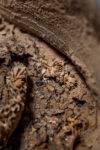 The coffin also contains the remains of a shroud and many leaves and flowers at head-height, likely from a crown of flowers. There were leaves found at abdomen level, as well. Another unique element of this burial is that the lead sarcophagus was not just anthropoid, but specifically molded to fit around the body of the deceased. These features strongly suggest he was someone of aristocratic status.
The coffin also contains the remains of a shroud and many leaves and flowers at head-height, likely from a crown of flowers. There were leaves found at abdomen level, as well. Another unique element of this burial is that the lead sarcophagus was not just anthropoid, but specifically molded to fit around the body of the deceased. These features strongly suggest he was someone of aristocratic status.
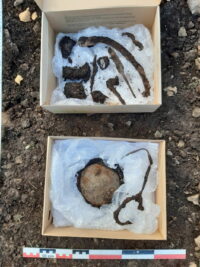 A richly furnished Viking grave has been unearthed in western Oslo, the first Viking-era grave replete with artifacts to be archaeologically excavated in the Norwegian capital.
A richly furnished Viking grave has been unearthed in western Oslo, the first Viking-era grave replete with artifacts to be archaeologically excavated in the Norwegian capital.